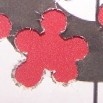I received the two strain screws from MidwayUSA today(shown in the photo) and took
some measurements from the bottom of the head to the tip of the screw, and logged the results
above each screw. I guess the thickness of the head is insignificant to it's functioning. Although
the screw head that looks most like the original is not the right screw for my revolver, it's the screw
with the smaller head that is for the 686 (according to Midway). I called S&W to get their opinion
on which screw was right for the 686. I had also mentioned that a gunsmith had ground a portion
of the tip off, as a trigger job, and he told me that they(S&W) are the ones who have "filed" the
tip off in order to get it to work the best with my individual revolver ! He said each revolver is unique,
and the tips of the strain screws were filed by them to get the best trigger functioning for each particular
gun. He suggested to use the strain screw that was designed for the revolver from Midway(middle screw)
and check the results. The middle screw was the one I figured on putting in anyway, and his agreement
determined it for sure. I guess each 686 revolver is a "unique" piece? I guess I am not as disgusted
with the gunsmith who worked on my gun as I was at first. I will put the gun to the test and see if it works ok.
Haka









